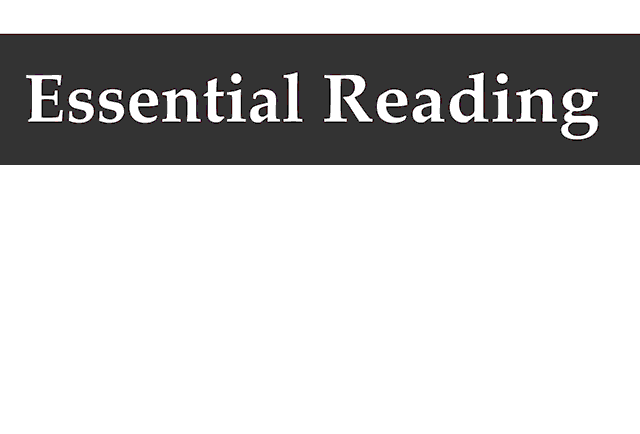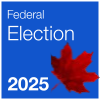 By Pepper Parr By Pepper Parr
March 31st, 2025
BURLINGTON, ON
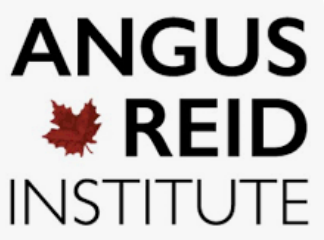 In a campaign that has been remarkable for its volatility and dynamism, a new element enters the race: relative stability. In a campaign that has been remarkable for its volatility and dynamism, a new element enters the race: relative stability.
New data from the non-profit Angus Reid Institute finds voter intention unchanged over the last week, with the Liberal Party holding an eight-point lead over the Conservatives, while the fortunes of the NDP and Bloc remain similarly unchanged.
Asked how they intend to vote, 46 per cent of Canadian voters say they will support the Liberals, compared to 38 per cent for the Conservative Party. Support for the NDP (7%) and Bloc Québécois (7%) continues to linger in single digits.
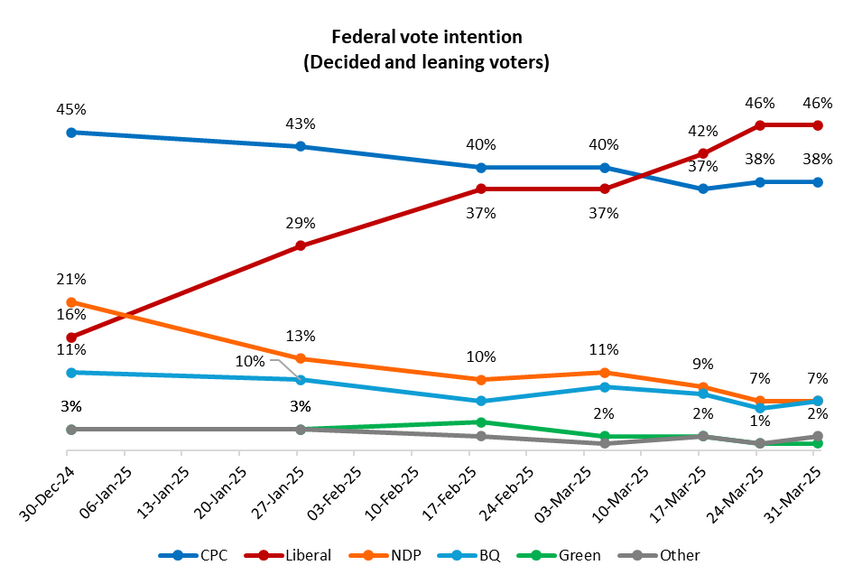
Liberal leader and Prime Minister Mark Carney continues to maintain an advantage among most demographic groups. Men aged 35- to 54-years-old are the only age-gender segment to be more likely to vote Conservative. The Liberals otherwise lead between four points (men older than 55) and 27 points (women older than 55).
Further, Carney’s positive net favourability among both men (+18) and women (+26) remains stable. His rivals – Conservative leader Pierre Poilievre and NDP leader Jagmeet Singh – struggle among one gender or the other. For Poilievre, this represents an ongoing inability to build positive impressions among women – three-in-five (61%) who say they view him unfavourably. For Singh, same problem, only among men, who by a two-to-one margin view him more negatively than positively.
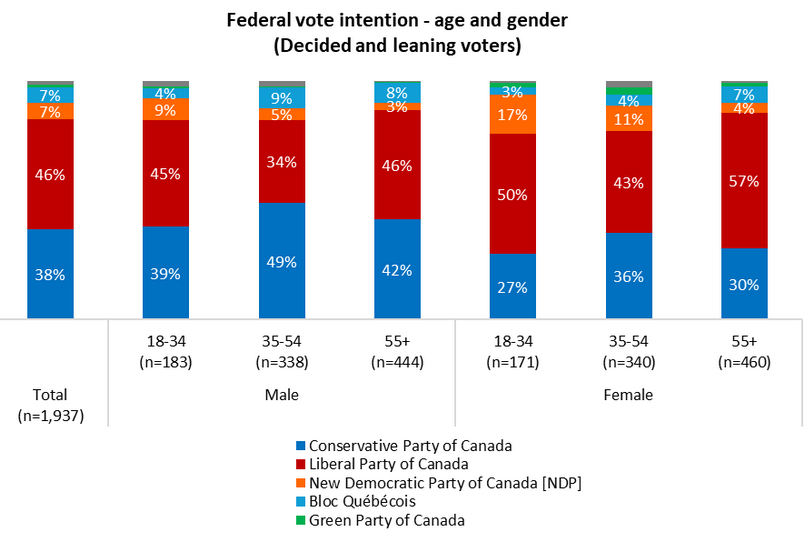
The resurgence of the Liberals fueled by Carney’s election to leader is partially driven by women voters returning to the party after abandoning it at the end of 2024, but also by picking up vote intention from men. In March 2021, support for the Liberals among men ranged from 27 per cent among 18- to 34-year-olds, to 30 per cent among men aged 35 to 54. The Carney Liberals currently are receiving support from 45 per cent of 18- to 34-year-old men and 46 per cent of those older than 54.
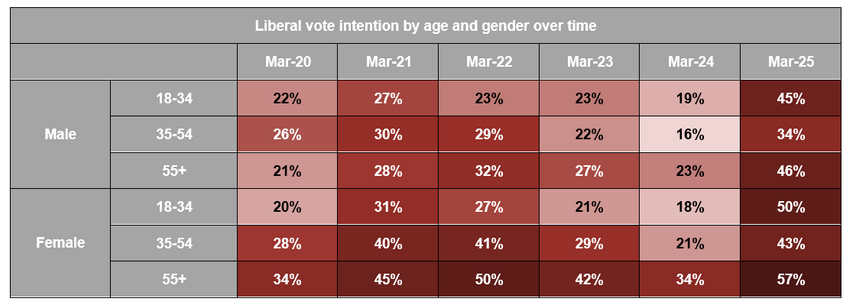
The battle at this point is between Conservative Party leader Pierre Poilievre and Liberal Prime Minister Mark Carney Carney. The focus is on the gender differences in the data Angus Reid has collected.
NDP leader Jagmeet Singh stands a chance of losing his British Columbia seat.
Hovering over all this is the Trump tariff threat – with a major announcement expected on Wednesday.
Liberal leader and Prime Minister Mark Carney had his first call with U.S. President Donald Trump, who struck a much more positive tone than seen in recent weeks and described the conversation as “very productive”. Trump also appeared to be more respectful of Carney, considering Trump called Carney by his official title and not governor, as he did with predecessor Justin Trudeau. Canada’s response to the U.S., and the tact taken by the leader of its future federal government, remains a key issue for the campaign.

 By Pepper Parr By Pepper Parr
April 1st, 2025
BURLINGTON, ON
Welcome news for the people flooded last summer – what took so long for these approvals?
The Ontario government is activating the Disaster Recovery Assistance for Ontarians (DRAO) program for Tyandaga Park Drive, Meadowbrook Road, and Fieldgate Drive in the City of Burlington, which experienced flooding caused by overflowing creeks, in the summer of 2024.
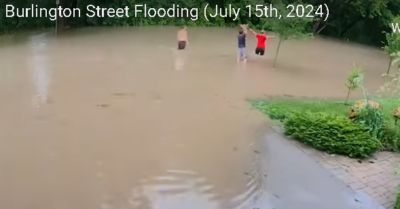 On July 15 and 16, 2024, extraordinary, severe thunderstorms and heavy rainfall led to flooding in several creekside neighborhoods in Burlington and other parts of the Greater Toronto Area. On July 15 and 16, 2024, extraordinary, severe thunderstorms and heavy rainfall led to flooding in several creekside neighborhoods in Burlington and other parts of the Greater Toronto Area.
On November 29, 2024, DRAO was activated in specific areas alongside creeks and rivers in parts of Burlington, Mississauga, Halton Hills, and Toronto due to flooding from the storm. Ontario is now activating the DRAO program for additional areas in Burlington that were also affected by overland flooding from the storm.
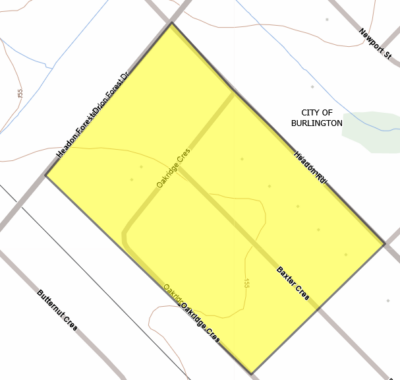 Very detailed maps on the areas covered by this announcement are provided. This is the Headon Forest map. The disaster assistance program applies to a primary residence and its basic contents, or to a small business, farm or not-for-profit organization. It provides assistance for emergency expenses and the costs to repair or replace essential property following a natural disaster not covered by insurance.
To find out if they may be eligible for assistance, if they are in the activation area, and for next steps, individuals, small businesses, farms and not-for-profit organizations should review the maps and program guidelines available ontario.ca/DisasterAssistance, or call 1-877-822-0116 or email disasterassistance@ontario.ca after speaking with their private insurance provider.
Residents with no insurance coverage, or whose insurance coverage is insufficient to cover essential costs, have until July 29, 2025 to apply for assistance through the program.
Additional Resources
Preparing for an emergency
Disaster Recovery Assistance for Ontarians Guidelines

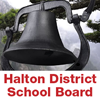 By Pepper Parr By Pepper Parr
March 31st, 2025
BURLINGTON, ON
Strengthening Schools Through Kindness, Connection and Community will explore the HDSB’s commitment to Kindness, Connection and Community, as outlined in the 2024-2028 Multi-Year Strategic Plan, and how it is being brought to life in schools and workspaces through meaningful actions.
Panelists will discuss how centring a culture of kindness in learning and working environments supports student and staff success and well-being, creating a genuine sense of belonging and the conditions for students to thrive.
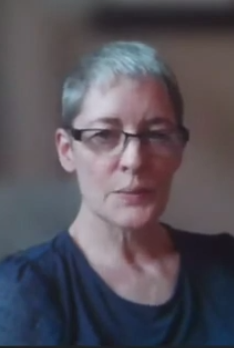 Amy Collard, Chair of the Halton District School Board. Joining the session as panelists will be Amy Collard, Chair of the HDSB, representation from HDSB students and staff, as well as Dr. John-Tyler Binfet, PhD, Professor of Education at the University of British Columbia. Together, the panel will explore how kindness, connection and community strengthen schools. Dr. Binfet will share insights on how students from Kindergarten to Grade 12 conceptualize kindness in learning environments and how they define and enact kindness to themselves and others.
Monday, April 7 from 6 – 7 p.m.
This will be a virtual event with the livestream linked on the HDSB website (hdsb.ca).
Registration is not required.
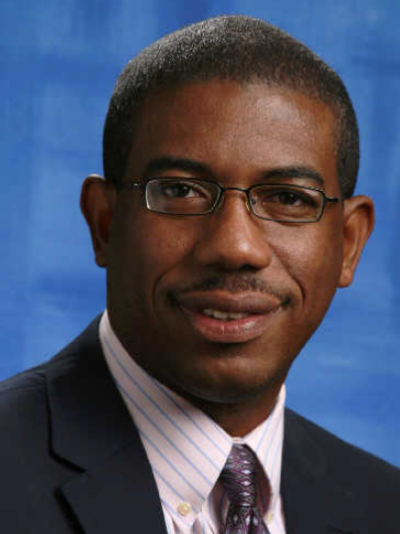 Curtis Ennis, Director of Education for the Halton District School Board. Curtis Ennis, Director of Education for the Halton District School Board explains the program this way: “This session presents an exciting opportunity to dive deeper into how centring a culture of Kindness, Connection and Community plays an integral role in strengthening our schools and workspaces.”
“By modeling empathy and respect in our daily actions, and striving to create learning and working spaces where everyone feels a genuine sense of belonging, we create a supportive environment and strengthen relationships among students, staff, families and the broader community. We look forward to coming together to discuss how these efforts help ensure that everyone in the HDSB community feels valued, supported and empowered to succeed.”
The 2024-2028 Multi-Year Strategic Plan sets direction and prioritizes the collective actions of all students, staff, families and community members. This plan ensures our efforts as an organization are aligned and coordinated to support more than 67,000 students, 11,000 staff and the broader HDSB community. The six commitments identified in this four-year plan intersect and overlap to ensure that we take a cohesive approach to fulfilling its objectives.
To this one has to add: Kindness, Connection and Community are important – very important but not at the expense of students graduating that cannot write a paragraph and cannot do simple math without their cell phone. Knowing something about the history of Canada and the importance of voting.
All one has to do is look south to get a sense of what a lousy education results in. We can avoid that and be kind, connected and participant in the community we live in.
the country

 By Pepper Parr By Pepper Parr
March 31st, 2025
BURLINGTON, ON
While the candidates are looking for votes, the voters in Burlington will want to know exactly where they will go on April 28th to cast their ballot.
That time around, at the federal level, Burlington had three MP’s.
In 2023, Elections Canada did a required review of the population in each constituency, held public hearings and revised many of the boundaries.
They also increased the number of seats in the House of Commons from 338 to 343
The result is one less seat for Burlington. What was once (1) Burlington, (2) Oakville North Burlington and (3) Milton is now just Burlington and Burlington North–Milton West
Burlington
BURLINGTON MAP
Population: 125,435
Number of registered electors (estimate) 99,533
Number of polling divisions: 258
Area: 76 km2
Boundaries description
Consists of that part of the City of Burlington lying southeasterly of a line described as follows: commencing at the intersection of the southwesterly limit of said city (Kerns Road) and Dundas Street; thence northeasterly along said street to Highway 407; thence southerly along said highway to Guelph Line; thence southeasterly along said line to Upper Middle Road; thence northeasterly along said road to Walkers Line; thence southeasterly along said line to Queen Elizabeth Way (Highway 403); thence northeasterly along Queen Elizabeth Way to the northeasterly limit of said city (Burloak Drive).
Burlington North–Milton West
Burlington North map
Your future electoral district is Burlington North–Milton West. This will be your electoral district for any general election called on or after April 23, 2024. Here is the information that is currently available:
Population: 125,575
Number of registered electors (estimate): 89,456
Number of polling divisions: 196
Area: 377 km2
Boundaries description
Consists of:
- that part of the City of Burlington lying northwesterly of a line described as follows: commencing at the intersection of the southwesterly limit of said city (Kerns Road) and Dundas Street; thence northeasterly along said street to Highway 407; thence southerly along said highway to Guelph Line; thence southeasterly along said line to Upper Middle Road; thence northeasterly along said road to Walkers Line; thence southeasterly along said line to Queen Elizabeth Way (Highway 403); thence northeasterly along Queen Elizabeth Way to the northeasterly limit of said city (Burloak Drive); and
- that part of the Town of Milton lying southwesterly of a line described as follows: commencing at the intersection of the southeasterly limit of said town (Lower Base Line West) and Regional Road 25; thence northwesterly along said road, Ontario Street South and Ontario Street North to Steeles Avenue East; thence southwesterly along said avenue to Martin Street; thence northwesterly along said street and Regional Road 25 to the northerly limit of said town (5 Side Road).
There was a time when the names and boundaries used by the federal government and the provincial government were the same.
Elections Canada has upgraded their boundaries based on Census date. Ontario has yet to upgrade their boundaries.

 By Staff By Staff
March 31st, 2025
BURLINGTON, ON
About 7,000 runners crossed the finish line in Hamilton’s annual Around the Bay road race Sunday. They ran in four events — 30 km, 15 km, 10 km and five km — along a new route that started and ended at Liuna Station on James Street N.
 There were different starting points for some of the races. Race director Anna Lewis said she felt “a sense of gratitude to the participants for showing up on a rainy day,” and to the organizers and roughly 500 volunteers who made the event possible.
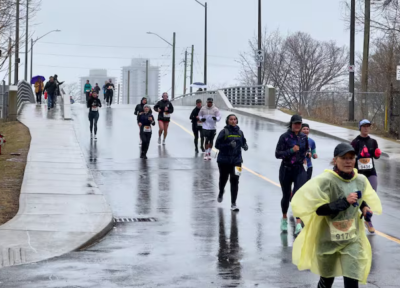 It was wet and cold  Hamilton Harbour is circled by the runners. Hamilton experienced rain and near-zero temperatures Sunday morning, but in much of southern Ontario, freezing rain caused power outages and dangerous driving conditions.
About 10,000 people registered to run, but Lewis told CBC Hamilton some decided not to attend because of the ice storm. “Weather always plays a role in turnout,” said Race director Anna Lewis .
This year’s 30-km race took runners north from Liuna Station to loop around Hamilton Harbour. At the 26-km mark runners went through Dundurn Castle and back to Liuna Station. Participants in the 10-km and 15-km routes ran along the same route but took shuttle buses to different starting lines.
Full race result can be found HERE

 By Pepper Parr By Pepper Parr
March 26th, 2025
BURLINGTON, ON
An update:
Our reader followed up with Hydro and learned that the message was legit. “I discussed this with Hydro staff, who said they don’t write the standard messages, and when they are addressed to a person they expect that person will act accordingly. I pointed out the similarity to a spam message and the reaction was indifferent.
From a loyal Gazette reader:
“This note just arrived in my mailbox.
 Huge monitor displaying the hydro system. Burlington Hydro also managed the Milton Hydro system.  Control desks “Apparently power will be out in Burlington next Monday morning. It up to users to deal with potential problems, like running their computers, websites, medical devices whatever.
“No mention of what locations, just a website to check updates (if your router will work with no power)
“I have been here for 15 years and have never heard of such a thing. If my “understanding is appreciated”, it certainly will not be given.
“Outrageous!”

 By Staff By Staff
March 29th, 2025
BURLINGTON, ON
Weather reports have been threatening something between 30 and 50 mm of rain and some freezing rain in parts of the province.
Burlington has dealt with this kind of weather before.
In December of 2013, during the Christmas holiday there was a storm that shut down a number of roads n the city – the rural areas were particularly hard hit.
Many of the people in rural Burlington gathered at the Kilbride Fire Station looking for answers. Two woman who showed up in their pajamas were worried about how long their emergency generator could run. The Fire Chief asked them what kind of generator they had. A red one they replied. It was that kind of an event.
We just might experience the same kind of storm: stock-up and be ready to help your neighbors.
Here are some of the pictures the Gazette published about that event.
 This was a tree that was not going to give in to the weight of the ice and snow. 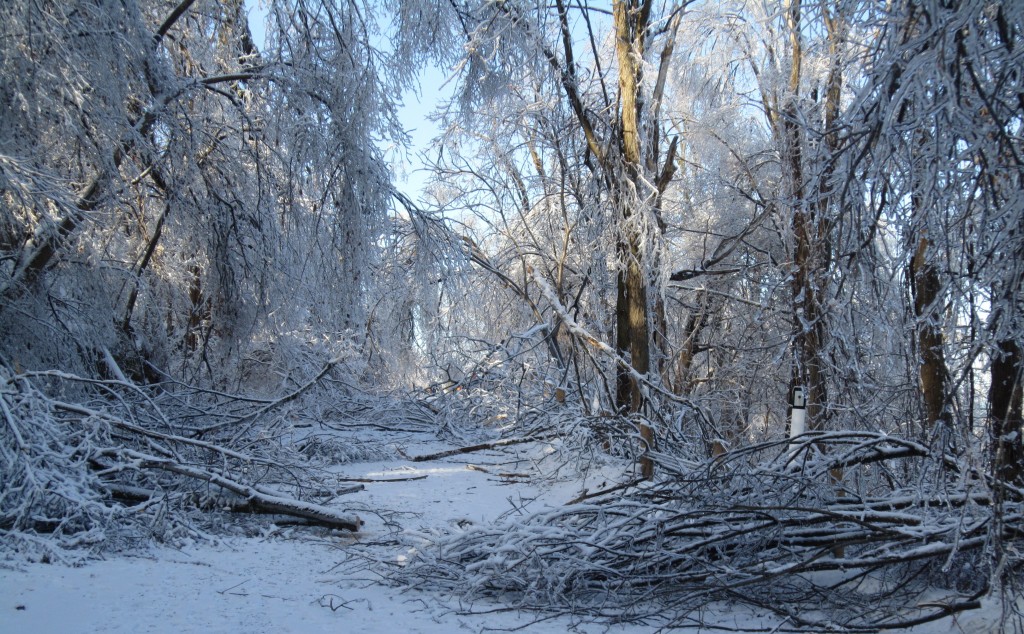 People on Millar Road couldn’t get in or get out – the road was completely blocked. Took days to clear up this one.  Some of the roads were clear – not as much as a branch on the ground. 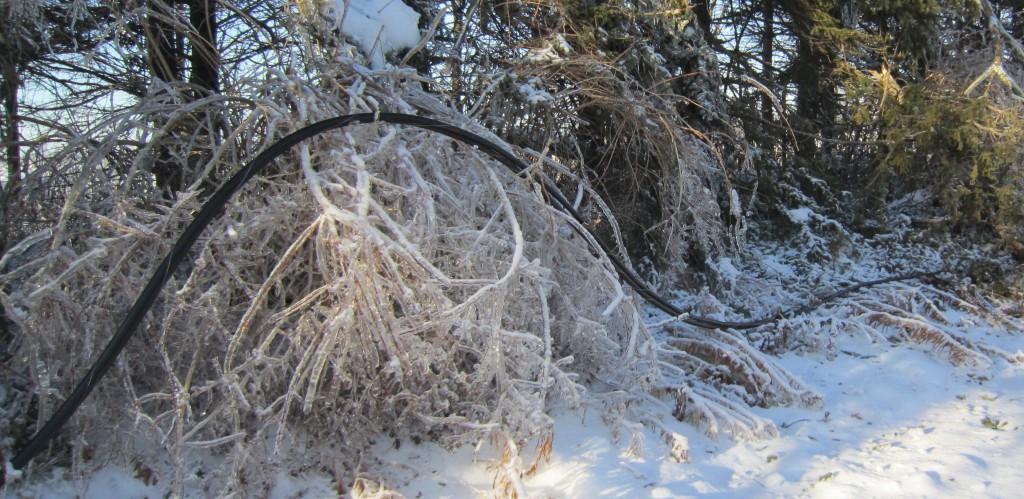 Live cables that had snapped were sitting at the side of a number of roads waiting for Hydro staff to locate them and get crews out to make repairs. 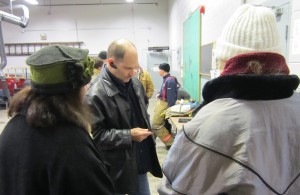 Dan Guatto, doing his best to communicate in an environment where there are a lot of things not working very well. His cell phone got him through most of the problems. 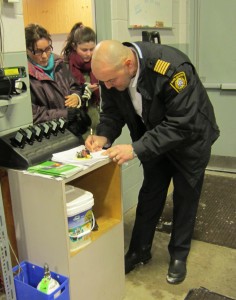 Fire chief Tony Bavota handing out cards with direct line telephone numbers and ensuring that people got the help they needed. Bavota said he wasn’t going to worry about lines of authority – if they need help – Bavota did everything he could to get it to them. 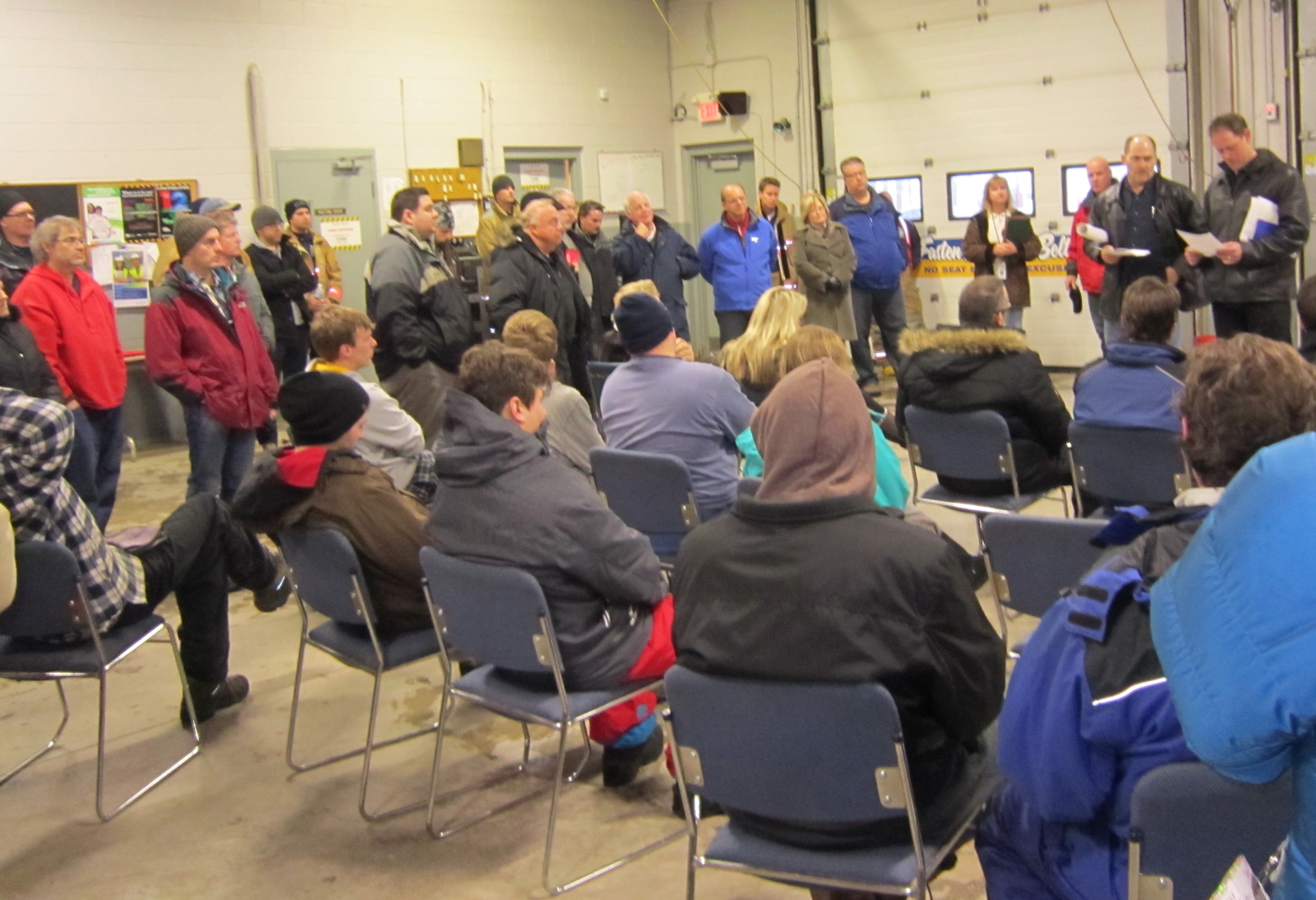 Senior City Hall staff and just about anyone who could be spared at Hydro were at the Kilbride Fire station to answer questions. 
 By Gib van Ert, Robert J. Currie and Allan Rock By Gib van Ert, Robert J. Currie and Allan Rock
March 26, 2025
BURLINGTON, ON
Originally published on Policy Options
Late in 2024, the incoming president of the United States, Donald Trump, began calling for the annexation of Canada.
What was first taken as a tasteless joke quickly emerged as a chief plank of the new administration’s foreign policy. On Jan. 7, a reporter asked Trump whether he intended to use military force against Canada – something he had threatened only moments earlier to use against Panama and Greenland. “No, economic force,” Trump replied.
Both military and economic force to annex another country are forbidden under Canadian and international law. Any U.S. takeover attempt already faces serious political and public resistance. But we also have legal and constitutional defences of our sovereignty, to be taken up if needed. Let us hope it does not come to that. But lawyers and judges must be ready in case it does.
Trump’s goal is clear
 Trump repeated his commitment to territorial aggrandizement in his inaugural address, saying: “The United States will once again consider itself a growing nation, one that increases our wealth, expands our territory, builds our cities, raises our expectations and carries our flag into new and beautiful horizons.” Since becoming president on Jan. 20, Trump has followed through with his threats in the form of on-again, off-again tariffs on various Canadian exports designed to cause severe damage to our economy.
He uses nonsensical justifications for tariffs, but his real goal is clear – the use of economic force to undermine Canadian sovereignty and pave the way for U.S. annexation.
Trump repeated his commitment to territorial aggrandizement in his inaugural address, saying: “The United States will once again consider itself a growing nation, one that increases our wealth, expands our territory, builds our cities, raises our expectations and carries our flag into new and beautiful horizons.”
He also invoked Manifest Destiny, the discredited 19th-century American belief in the irresistible spread of its empire across North America.
International law is on Canada’s side
The acquisition of territory by force has been illegal under international law since the end of the Second World War – ironically because of U.S. leadership at the San Francisco conference that drafted the 1945 United Nations Charter.
Article 2(4) requires all UN members to “refrain in their international relations from the threat or use of force against the territorial integrity or political independence of any state.”
The UN Declaration on Principles of International Law Concerning Friendly Relations and Co-Operation Among States affirms that no acquisition of territory by “the threat or use of force shall be recognized as legal” and no state may use “economic, political or any other type of measures to coerce another state in order to obtain from it the subordination of its exercise of its sovereign rights.”
Why are younger Canadians more susceptible to Trump and the lure of the 51st state?
We live in a dangerous world. Canada needs to bulk up
Donald Trump is changing the political culture of the United States
 The Supreme Court of Canada: a majority are female. This prohibition is also a matter of international human-rights law, specifically the right to self-determination. Of particular importance to Canada, Article 3 of the UN Declaration on the Rights of Indigenous Peoples specifically confirms the right of Indigenous Peoples to “freely determine their political status.”
These international norms are also part of Canadian law. They represent customary international law, which the Supreme Court of Canada has repeatedly affirmed forms part of Canadian common law.
This means that the international legal principles of Canadian sovereignty over its territory, the right of Canadians to self-determination and the illegality of foreign acquisition of territory by threat or use of force, including economic force, are rules of Canadian common law that must, in proper cases, be given effect by Canadian judges.
The Constitution assumes Canadian sovereignty
Canadian sovereignty and territorial integrity also underpin our written Constitution. The Constitution Act, 1867 (formerly the British North America Act) vests executive power in the Sovereign, establishes a Privy Council for Canada and continues the command-in-chief of Canada’s land and naval forces in the Sovereign as head of state.
These provisions are irreconcilable with any transfer of executive power from the head of state, as advised by Canadian political leaders, to a foreign power.
Major amendments to the Constitution in 1982 added the Canadian Charter of Rights and Freedoms, the protection of Aboriginal rights and a new mechanism for amending the Constitution without British involvement. Throughout its provisions, the Constitution Act, 1982 assumes, and requires, Canadian independence.
Section 3 confirms the rights of all Canadian citizens to vote in elections for members of the House of Commons and to serve as MPs. The continued existence of the Commons as the elective element of our federal legislature is the essential prerequisite of these rights.
Section 6 declares the right of every Canadian citizen to enter, remain in and leave Canada – a meaningless right without a Canada to enter, remain in and leave.
Part V sets out several ways in which the Constitution can be amended. Capitulation to a foreign power is not one of them.
Finally, Section 52(1) provides that the Constitution is the supreme law of Canada and that any law inconsistent with it is of no force or effect. The force of all the Constitution’s other provisions turns on this one, which empowers Canadian courts to strike down other laws as unconstitutional.
Indigenous rights are also critical
The position of Canada’s Indigenous peoples must also be remembered.
Modern Canada is the product of a series of territorial encroachments and acquisitions by France and Britain in pre-modern times. Canadian courts continue to struggle with the consequences of that history, empowered by the 1982 Constitution’s recognition and affirmation in Section 35 of the existing Aboriginal and treaty rights of the Aboriginal peoples of Canada.
This process of reconciliation gained new impetus with Canada’s adherence to the UN Declaration on the Rights of Indigenous Peoples in 2016 and Parliament’s recognition of that declaration as a universal international human-rights instrument with application in Canadian law.
All of this gives legal foundation to an instinct that should come naturally to anyone living on this continent: we are long past the point in our history where Indigenous lands and traditional territories can be swapped back and forth between states without Indigenous consent.
Judicial resistance may be needed
The United States seems now to have turned against the principles it once championed. But those principles remain the foundation of both the international legal order and Canada’s laws.
American attempts to force annexation by economic means are being met with strong resistance from our political leaders and the public. That resistance may succeed and Trump’s dream of making Canada the 51st state may be shattered by politics alone.
But if Canada-U.S. relations so deteriorate that our independence is actively threatened, political and popular resistance may require the support of legal and judicial resistance. The annexation of Canada by a foreign power is manifestly illegal. Canada’s courts must not hesitate to say so.
Gib van Ert is a partner at Olthius van Ert and a former president of the Canadian Council on International Law.
Robert J. Currie, K.C., is the Viscount Bennett Professor of Law in the Schulich School of Law at Dalhousie University.
Allan Rock is president emeritus of the University of Ottawa. He has served as federal minister of justice and attorney general, as well as Canadian ambassador to the United Nations.

 By Staff By Staff
March 29th, 2025
BURLINGTON, ON
This is the first time we recall hearing City Hall set out what they would like to see coming out of the federal election that takes place on April 28th.
City Hall had this to say: “On April 28, Canadians will return to ballot boxes to make their voices heard in what could be a defining election for the country. As Burlington residents consider the future and our shared place in it, the City continues to advocate for meaningful and robust partnerships with all parties in support of our community’s goals in 2025 and beyond.
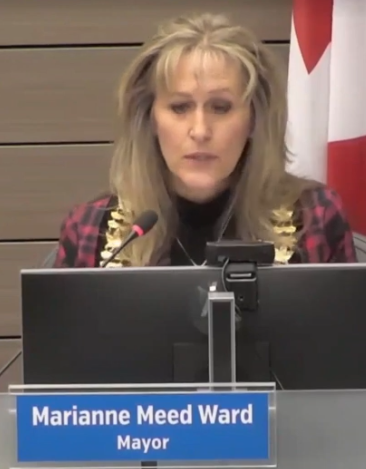 “Strong, multi-level government relationships will preserve the great quality of life for everyone in Burlington. “Strong, multi-level government relationships will preserve the great quality of life for everyone in Burlington.
“Burlington is focused on five policy priorities that, through collaboration with the Government of Canada over the next four years, will help us make a difference.
“Five Policy Priorities for the Federal Government
-
-
- Supporting industry and protecting jobs, businesses, and the economy..
- Negotiating a New Municipal Growth Framework.
- Advancing affordable housing solutions..
- Addressing the homelessness crisis
- Protecting the natural environment and taking action on climate change.”
Mayor Marianne Meed Ward said “We’re committed to working with our partners at the federal government to meet the needs of our community. We’re connecting with each candidate in this election to ensure they know our priorities. Municipalities know our communities best, and we can’t solve the issues we face alone. We look forward to working with the new government. I encourage everyone to get out and vote to make your voice heard on the issues we face.”

 By Staff By Staff
March 29th, 2025
BURLINGTON, ON
Shelly Sanders, author of The Night Sparrow, will be at A Different Drummer Books on Sunday, April 6, starting 2:00 pm.
 “Sanders’ page-turning narrative recounts women’s comradeship and courage in the face of carnage and peril from both outside and inside their ranks. With each turn of the page, the author’s unwavering compassion for her characters shines through…Sanders’ novel illuminates a little-known chapter of women in combat and their astonishing contributions during World War Two.” –Jeanette Lynes “Sanders’ page-turning narrative recounts women’s comradeship and courage in the face of carnage and peril from both outside and inside their ranks. With each turn of the page, the author’s unwavering compassion for her characters shines through…Sanders’ novel illuminates a little-known chapter of women in combat and their astonishing contributions during World War Two.” –Jeanette Lynes
If the hype is any indication – this might be something you want to take in.
“… Illustrious journalist, educator and novelist Shelly Sanders visits the bookshop to share her riveting new work of historical fiction in a vivid presentation.
“…a tense, engrossing tale of World War Two. Based on true events, this is an improbably beautiful novel about a brutal episode in history.” –Janie Chang
Admission is free.

 By Jim Portside By Jim Portside
March 29th, 2025
BURLINGTON, ON
The macro picture one gets from the 2024 Sunshine list is hard enough to swallow – the macro level look is close to mind boggling. Does the angle of the pay increases graphic replicate what is done in the private sector?
Here are some of the more notable salary increases.
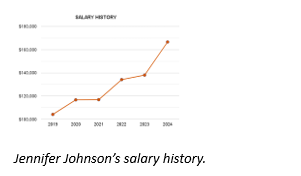 Jennifer Johnson earned 20.68% more in 2024. Ms. Johnson’s job title changed from “Senior Project Manager, Facilities and Buildings” to “Senior Project Manager”. Jennifer Johnson earned 20.68% more in 2024. Ms. Johnson’s job title changed from “Senior Project Manager, Facilities and Buildings” to “Senior Project Manager”.
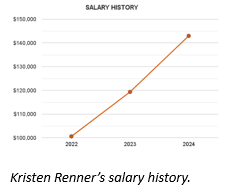
Kirsten Renner earned 19.81% more in 2024. Ms. Renner’s job title changed from “Supervisor, Payroll Services” to “Supervisor”.
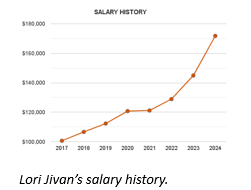
Lori Jivan earned 18.53% more in 2024. Ms. Jivan’s job title changed from “Supervisor, Budgets and Policies” to “Manager”. It’s nice to see someone who does a stellar job of presenting the budget to taxpayers being richly rewarded.
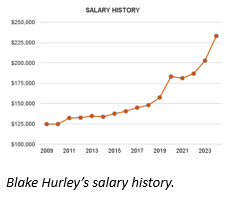
Blake Hurley earned 14.97% more in 2024. Mr. Hurley’s job title changed from “Executive Director, Legal Services and Corporate Council” to “Commissioner”.
These salary charts remind me of a U2 song – “Hello, hello. We’re at a place called Vertigo”?
These are all good people – the question one has to ask is: are these increases realistic and can the city afford it?
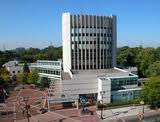 All is well at city hall. After pushing through a 10.21% increase to property tax revenue for 2024, with almost no population growth, staff is richly rewarding their own efforts. Our mayor likes to call 2024’s 10.21% increase a 4.99% impact on our total tax bill but the reality is the city received 10.21% more revenue from taxpayers and, based on the Sunshine List, they know how to spend the money. All is well at city hall. After pushing through a 10.21% increase to property tax revenue for 2024, with almost no population growth, staff is richly rewarding their own efforts. Our mayor likes to call 2024’s 10.21% increase a 4.99% impact on our total tax bill but the reality is the city received 10.21% more revenue from taxpayers and, based on the Sunshine List, they know how to spend the money.
Related news story:
Burlington as it is seen on the 2024 Sunshine list.
Jim Portside is a Burlington resident who retired after several decades as a successful business owner

 By Staff By Staff
March 28th, 2025
BURLINGTON, ON
 Conservation Halton advises that Environment Canada and the Ministry of Natural Resources (MNR) Surface Water Monitoring Centre (SWMC) are forecasting a slow-moving low-pressure system that will bring widespread showers across southern Ontario starting today and continuing both tomorrow, Sunday and into early Monday before moving out of our area. Current local forecasts indicate between 30 and 50 mm of rain possible with the potential for freezing rain overnight Saturday into Sunday as temperatures fall below freezing. The anticipated rainfall combined with increased runoff from wet soil conditions will likely result in elevated water levels in rivers and streams within our jurisdiction. Conservation Halton advises that Environment Canada and the Ministry of Natural Resources (MNR) Surface Water Monitoring Centre (SWMC) are forecasting a slow-moving low-pressure system that will bring widespread showers across southern Ontario starting today and continuing both tomorrow, Sunday and into early Monday before moving out of our area. Current local forecasts indicate between 30 and 50 mm of rain possible with the potential for freezing rain overnight Saturday into Sunday as temperatures fall below freezing. The anticipated rainfall combined with increased runoff from wet soil conditions will likely result in elevated water levels in rivers and streams within our jurisdiction.
 Keep children away from creeks where water is flowing faster than normal. Widespread flooding is not anticipated, however, fast flowing water and flooding of low-lying areas, natural floodplains, and areas with poor drainage may be expected.
Conservation Halton is asking all residents and children to keep a safe distance from all watercourses and structures such as bridges, culverts, and dams. Elevated water levels, fast flowing water, and cold water temperatures combined with slippery conditions along stream banks continue to make these locations extremely dangerous. Please alert children in your care of these imminent dangers.
Conservation Halton will continue to monitor stream and weather conditions and will issue an update to this Watershed Conditions Statement – Water Safety message as conditions warrant.
This Watershed Conditions Statement – Water Safety will be in effect through Tuesday April 1, 2025.

 By Pepper Parr By Pepper Parr
March 28th, 2025
BURLINGTON, ON
The Sunshine list is out.
The high-level numbers are staggering:
There are 377,667 people on the list that runs 18,800 pages.
School Boards and teachers account for much of the increase.
 The civil servant salary listing was created by the Mike Harris government in 2006. Media quickly named it the Sunshine list. “Nearly half the growth on the list was driven by the school board sector, with teachers contributing to 87 per cent of this increase,” Treasury Board President Caroline Mulroney said in a statement Friday.
The tally from 2024 is up 25.6 per cent from 300,572 workers in 2023 — when it topped the 300,000 mark for the first time — and 266,903 the year before.
The list includes Ford, his cabinet ministers and all MPPs — whose salaries have been frozen since 2008.
MPPs make a base rate of $116,500 a year and Ford recently mused about giving them a raise.
“I don’t want to sound like a bleeding heart for politicians, but come on, folks, these guys work their backs off … and it’s not fair,” the premier told reporters after swearing in his new cabinet last week.
In contrast, federal MPs earn $203,100 and Toronto city councillors Thursday night voted themselves a 24 per cent pay increase of about $33,000 annually to $170,588.60
The sunshine list with its $100,000 threshold was established in 1996 by former PC premier Mike Harris as a transparency measure, but has lost impact over three decades because of inflation.
We will beaver away at digging out the specifics for the City of Burlington and the Halton District School Board.
Be patient – this will take some time.

 By Kevin Powers By Kevin Powers
March 27th, 2025
BURLINGTON, ON
The Hamilton Spectator chose not to publish this opinion piece.
Something as important as the mining of aggregate in rural Burlington deserves all the view points it can get.
No Need for New Quarries? Tell That to the Free Market
Across southern Ontario, the battle over new quarries rages on. Local opponents—armed with “No Quarry” signs and cries of “No Need”—paint aggregate operators as reckless profiteers tearing up the land for no reason. They argue the province has more than enough gravel, sand, and stone to go around, so why approve more pits?
Here’s the flaw in their logic: they don’t understand the basic laws of supply and demand. No operator in their right mind spends millions chasing a new license and risking rejection, unless demand is there—and it is.
 The Jefferson slamander was the major obstacle when the first application for an aggregate license was turned down. If there were an oversupply, you’d see it—prices crashing, pits shuttering, companies bailing. That’s not happening. The Ontario Stone, Sand & Gravel Association pegs annual consumption at 164 million tonnes, and the number of licenses has dropped by 28 since 2013. Operators aren’t flooding the market; they’re scrambling to keep up. The free market doesn’t lie—businesses don’t risk millions on a hunch when gravel’s piling up unsold.
Opponents might mean well, worried about dust, noise, or nature. Fair enough—nobody wants a quarry next door. But crying “no need” defies economic sense and assumes operators are either dumb or masochistic. They’re neither. They’re businesses, not charities, and they’ve got data—construction forecasts, infrastructure plans, population trends—telling them the juice is worth the squeeze. If they see demand drying up, they’re not going to risk millions of dollars trying to bring on new supply.
The irony? By stalling new quarries, critics could choke the very growth they take for granted—roads they drive, homes they live in. The Greater Golden Horseshoe is not swimming in aggregate; it’s rationing a shrinking stash.
The Aggregate Resources Act doesn’t ask for a “market need” test because it trusts the market to sort itself out. Maybe it’s time opponents did too. Operators aren’t the enemy here—they’re just reading the room. If there’s no need, they won’t dig. But the numbers say otherwise, and the free market’s already placing its bets.

 By Staff By Staff
March 27th, 2025
BURLINGTON, ON
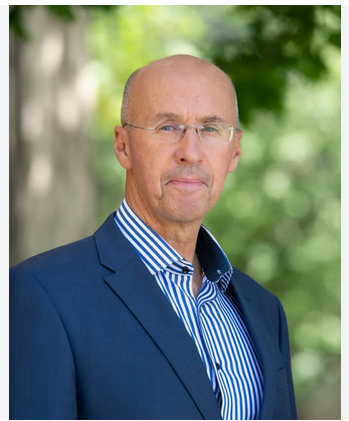 Kevin Page: head of the Institute of Fiscal Studies and Democracy at the University of Ottawa. Kevin Page, former parliamentary budget officer and head of the Institute of Fiscal Studies and Democracy at the University of Ottawa, said in an interview this week that the economy will not collapse but Canada is likely to face a recession due to Trump’s tariff wars.
“The geopolitical uncertainties could have a worse impact,” he said.
“It’s not just that the stock markets get rattled. It’s also that people start to feel that it’s going to get worse. And then everybody slows down. Everybody stops spending.”
However, he said, the bigger picture of the government’s finances shows Ottawa can weather the storm ahead and is in a position to support the hardest hit sectors and workers.
“Our debt to GDP numbers are better than other countries, much, much better than the United States. So we could provide that kind of shock absorber if — depending on what happens — it can help Canadians. So in that sense, like, you know, we have some built-in resilience.”

 By Staff By Staff
March 27th, 2025
BURLINGTON, ON
What’s with the Liberal surge? Recent Grit switchers say it’s driven by Carney, Trump’s threats
Vote commitment among new Liberals far less solid than those who stuck with party through lows of 2024
The slings and arrows of outrageous fortune suffered by the NDP and Conservative Party of Canada in recent months have reversed the fortunes of the Liberal Party – at least for now – leaving many to wonder how we got here.
After leading comfortably in the polls for the better part of two years, the Conservative Party of Canada now faces an upward battle to regain even ground against new Prime Minister Mark Carney and his Liberals.
What happened?
 New data from the non-profit Angus Reid Institute provide some answers to these questions. Asked what their main reasons have been, voters who have switched to the Liberals since the beginning of the year, more than half (56%) say they are motivated by the new leader, Carney, about the same number who also say U.S. President Donald Trump’s threats have pushed them to support the incumbents. Three-in-10 (30%) say they believe the Liberals are the best way to prevent a Conservative government and this is one of the driving factors. New data from the non-profit Angus Reid Institute provide some answers to these questions. Asked what their main reasons have been, voters who have switched to the Liberals since the beginning of the year, more than half (56%) say they are motivated by the new leader, Carney, about the same number who also say U.S. President Donald Trump’s threats have pushed them to support the incumbents. Three-in-10 (30%) say they believe the Liberals are the best way to prevent a Conservative government and this is one of the driving factors.
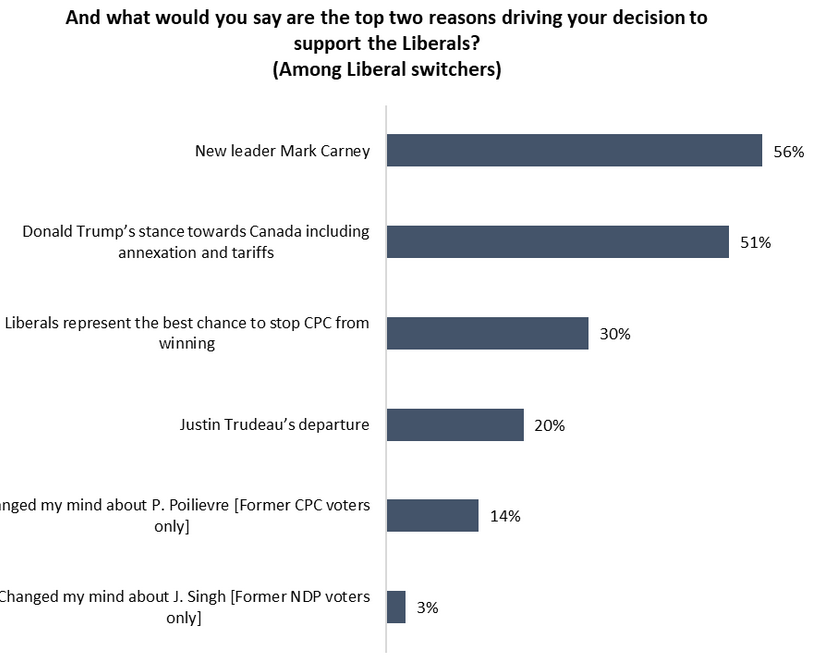
Where did they come from?
Among these “switchers” the largest group say they were formerly supporting the NDP (35%) while slightly fewer have jumped from the CPC (29%). A significant portion (16%) were undecided, while importantly, 12 per cent were Bloc Québécois voters, and have improved the Liberals chances in Quebec by their decision to swap.
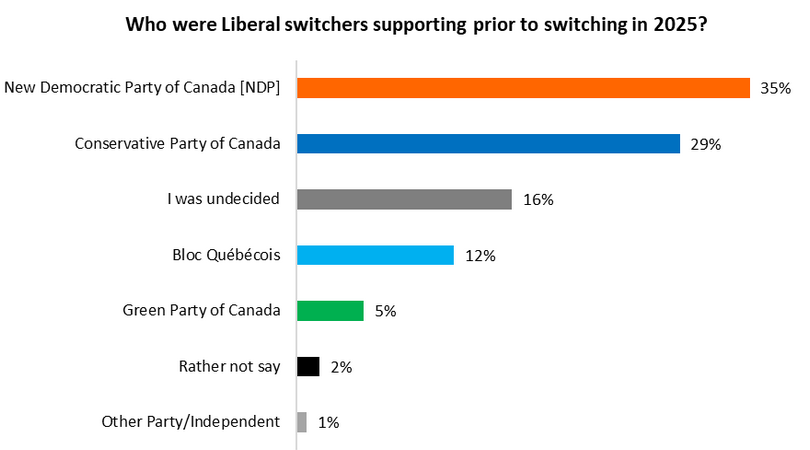
And why?
One of the motivating factors is the elevated concern over U.S. relations and the threat of tariffs. Among those who have switched to the Liberals and those who supported the party before this year, more than half say that this issue is a top one for them, personally.
This is approximately double the level of concern for that issue among non-Liberal supporters.
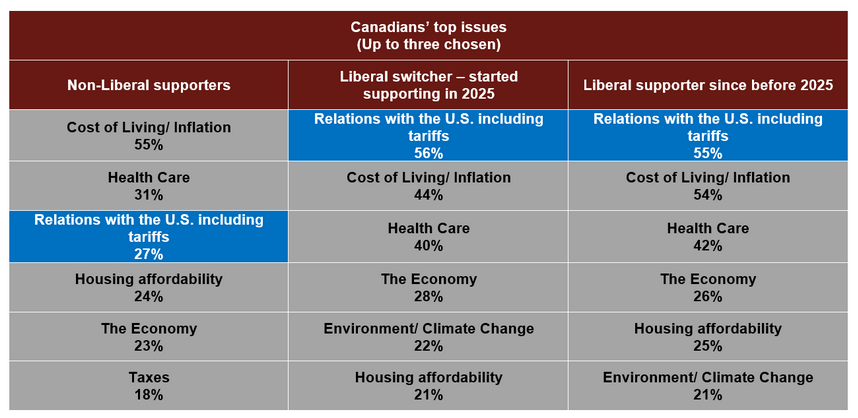

 By Staff By Staff
March 27th, 2025
BURLINGTON ON
On Saturday, March 29, three Lakeshore West evening trips will end at Aldershot GO. Customers can connect to a shuttle bus to continue to/past West Harbour GO and are encouraged to check schedules before travelling.
On Sunday, March 30, Lakeshore West rail service will not run to or past West Harbour GO:
- Customers going to West Harbour GO can connect to Route 18S GO buses at Aldershot GO station.
- There will be no GO Train service at St. Catharines GO and Niagara Falls GO that day.
- For customers heading to Niagara Falls, please connect to a regularly schedules Route 12 GO Bus to travel between Niagara Falls, St. Catharines and Burlington GO stations.
Crews will be signal testing on Sunday with test trains expected to travel along the Lakeshore West Line through Hamilton from 1:00pm to 9:30pm affecting level crossings at Sherman, Wentworth, Victoria and Wellington. While no loud train horn or whistle noise is anticipated, pedestrian and vehicular traffic may be impacted. Residents and motorists should be aware of increased train activity and are urged to use caution when driving or walking over tracks.
Riders can transfer for free with One Fare between GO Transit and most local agencies, including the TTC. Customers are encouraged to use gotransit.com to plan their trips. You can also check the GO Transit Service Updates page for real-time details.
Regular service will resume on Monday, March 31.


 By Pepper Parr By Pepper Parr
March 27th, 2025
BURLINGTON, ON
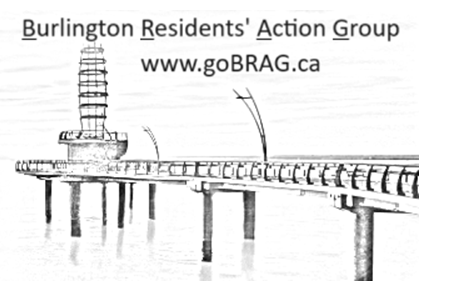 BRAG – Burlington Resident’s Action Group – exists to promote transparency, efficiency, accountability, fiscal responsibility, and a workable governance structure. BRAG – Burlington Resident’s Action Group – exists to promote transparency, efficiency, accountability, fiscal responsibility, and a workable governance structure.
Stephen White published the following on the BRAG website (GoBrag.ca)
“I recently had an opportunity to review the letter that my BRAG colleague, Blair Smith, sent to the City of Burlington’s Commissioner of Community Services Division, Jacqueline Johnson, regarding a proposed City Directory. Blair’s letter contained a unique and interesting idea on how the city could improve service delivery by posting a detailed listing of city employees and their contact information alongside a summary of what projects or undertakings for which they were responsible.
This original idea, patterned on similar directories that exist within the province of Ontario and the City of Toronto, would dramatically improve access to civic officials while reducing the delay in securing information. No sooner than Blair sent his communication, then back came a cursory reply in two days essentially telling him the city already had such a service in place.
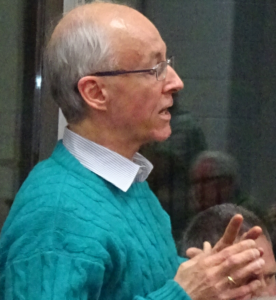 Stephen White Well, actually, it didn’t. Truth is, it has a directory which is hard to access, and which contains limited information. What Blair envisaged, and what the city has, are light years apart.
What is also light years apart is the city’s understanding of the term “citizen engagement”. The way I understand it, ordinary citizens should be able to propose ideas to civic officials with the expectation that they would be carefully reviewed, researched and evaluated according to their feasibility and merits. However, what typically drives the city’s response is how quickly it can get an answer back saying “thanks but no thanks”, minus the full and thorough consideration.
“Father Knows Best”
Every time a city official provides feedback to a citizen on an idea or proposal it reminds me of that old television show “Father Knows Best”. For those too young to remember, this show ran in the 1950’s and profiled a typical middle class American family living in a town called Springfield. The show starred Robert Young in the role of Jim Anderson, the husband and father, Jane Wyatt as his wife Margaret, and their three children (i.e. Betty, Bud and Kathy) played by Elinor Donahue, Billy Gray and Lauren Chapin respectively. The show ran from 1954 to 1960.
This hugely popular television series was purportedly the embodiment of the quintessential American family, complete with all its ups and downs, trials and tribulations, and everything in between. Each week, viewers tuned in and were treated to the challenges and adventures that the Andersons underwent. However, the guiding premise throughout the show was that no matter the challenge, problem or uncertainty, Jim (i.e. Robert Young) had it all under control. Under his tutelage and wisdom, the family steered confidently through each problem or near-disaster without missing a beat. Anytime one of the kids veered off the straight and narrow, Jim was there to lead them in the right course.
 Shows like “Father Knows Best” gave comfort to people who feared uncertainty, and provided a reassurance that everything would be just fine. For instance, if Bud ever challenged his father about why his allowance wasn’t more, or balked at taking out the garbage, or expressed dismay at not being able to borrow the family car, Jim Anderson was there to offer a controlled and disciplined rebuke to gently put him in his place. Jim Anderson was the archetype of the loving father. Robert Young played his role well. Not surprisingly perhaps he later got tapped to play Marcus Welby, M.D., in the television show with the same name, another wise guiding and controlling authority figure.
The 1950’s was the height of the Cold War. It was the era of mass conformity, unquestioned allegiance to country, and the McCarthy witch-hunts, and there was a pervasive fear that subversives, criminals, or Communists, were around every corner. One had to be vigilant and constantly on guard.
Shows like “Father Knows Best” gave comfort to people who feared uncertainty, and provided a reassurance that everything would be just fine. All one had to do was trust in Jim Anderson (aka Robert Young), and all would be well.
The City as the Embodiment of all Knowledge, Wisdom and Virtue
The City of Burlington is a lot like Jim Anderson. Every time a recalcitrant citizen asks a probing question, or makes a suggestion, or challenges the status quo, the firm, guiding hand of the grey eminence emerges to quietly, but resolutely, put that person in their place. Authority shouldn’t be questioned. The role of the average citizen is to pay taxes and quietly obey. Don’t make noise. Don’t make waves. Be polite and respectful, and defer to authority at all times. Don’t go to budget consultation meetings and ask challenging questions like why Service Burlington doesn’t work very well, or why the City needs a budget increase three times the inflation rate, or why citizens are paying for a litany of silly, wasteful projects from Love Your Neighbour through to unnecessary cultural programs.
Those of us who participated in last year’s budget consultation exercise routinely saw this on display. No matter what the question, the comment or the proposal, the city always had an answer for everyone which usually ranged from “That won’t work” to “It’s too expensive” to “We’ll think about it”. How many of Eric Stern’s 35 proposals that were submitted on behalf of BRAG resulted in an intensive analysis or investigation? Answer: none.
And Back Again
 Blair Smith with colleague Lynne Crosby standing outside Queen’s Park in Toronto. This brings us full circle to Blair Smith’s City Directory proposal and his original ask. If I really believed the city took his suggestion seriously, here’s what I would have naturally expected:
A telephone call to Blair to gather more details, or an e-mail invitation to schedule a meeting or Zoom call.
Contact with the Ontario government or the City of Toronto to see how, in fact, their directories work, what information is contained in it, how it is set up, and how it is managed.
A feasibility study to evaluate the relative benefits and costs of doing this.
An evaluation by a sub-committee of whether or how this could be done.
A response back to Blair within a four-to-six-week timeframe.
However, truth be told, the city really isn’t interested in this form of engagement. In fact, they aren’t really interested in listening to citizens, or entertaining new ideas, or critically examining and implementing new business processes. The city is interested in what many of us might cynically describe as a “tick the box” exercise. The aim isn’t to critically consider Blair’s response, or any other citizen’s input for that matter. The aim is to get a response back in 72 hours, and close the file. Case closed. Performance metric successfully achieved. Tick the box. Done.
Just Eat the Food, and to Hell with the Feedback
 Hundreds lined up for the food. Other than talking about the numbers City Hall never did publish an analysis of what they learned and how that impacted the decisions made. Every year the city hosts an event called “Food for Feedback” at Central Park. Ostensibly, this event provides residents with an opportunity to partake in a meal in exchange for providing feedback to the mayor, city councillors, and various civic officials in attendance, on a range of community activities and topics. According to the website “Feedback collected at the event will help the City continue to improve services and initiatives.”
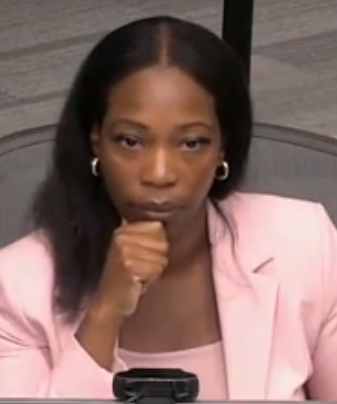 Community Services Division, Jacqueline Johnson I doubt that most of the suggestions that are generated through this forum would equate in the level of thought or detail that Blair provided in his proposal. If Blair’s proposal barely elicits a cursory response what would make any citizen believe the city takes seriously suggestions that are proffered with lesser substance?
“After all: The City, like Father, knows best!”
Some questions for the BRAG people;
Have they asked to meet with Commissioner xxx
Have they asked to meet with Hassaan Basit, CAO for the City?
Could BRAG not begin to create a Directory and make it available to the public. The org chart is public information. Use that as a base document and add names, email addresses and telephone numbers. See it as public service at its best.


 By Pepper Parr By Pepper Parr
March 27th, 2027
BURLINGTON, ON
In politics optics is everything.
A sound bite can kill a campaign.
Earlier this week, the Conservatives held two events; one in Hamilton and a second one in Stoney Creek. Both were reported to have drawn crowds of more than 4000 people.
Yesterday, the Liberals held an event in Windsor beneath a bridge that crosses the Detroit River.
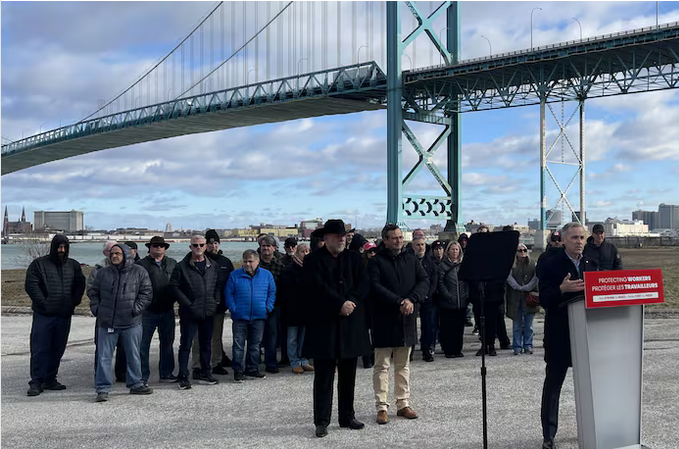
The two Conservative events were massive when compared to what the Liberals put on in Windsor.
 Conservatives gather in Stoney Creek  Audience size for the Hamilton event was reported to be 4500  Liberals gather in Kitchener. Prime Minister Carney had to put his campaign on hold for a day to return to Ottawa, meet with his Cabinet to respond to the Trump latest tariff announcement. The Liberals did up their game in Kitchener last night.

 By Tom Parkin By Tom Parkin
March 27th, 2025
BURLINGTON, ON
NDP would eliminate tax on incomes under $19,500, reduce tax by $505 for others with incomes under $177,882 and give nothing to incomes over $235,632.
Contrasting with Liberal leader Mark Carney’s “middle class” tax cut and Conservative leader Pierre Poilievre’s “tax cut for workers,” NDP leader Jagmeet Singh today released a tax plan that doesn’t give more money to Galen Weston than a worker earning $60,000.
Singh’s tax plan didn’t come with a cynical, mischaracterizing name, but it would eliminate federal income tax on incomes under $19,500 and cut tax by $505 for everybody with an income tax between $19,500 and $177,882.
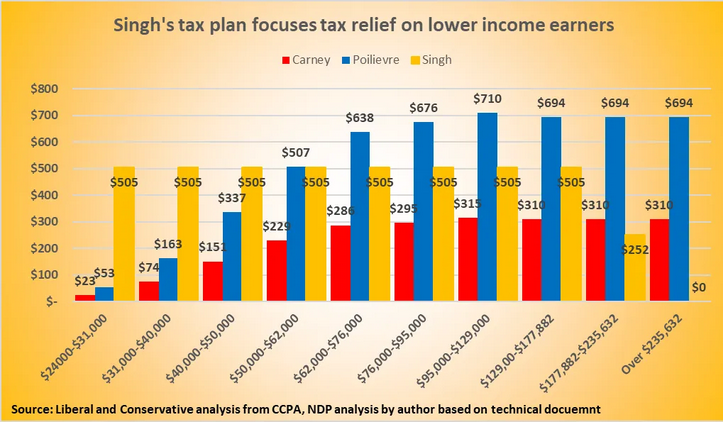
Above $177,882, the $505 benefit would phase-out and be totally eliminated for those with a taxable income of $235,632 or more.
The tax plans of both Mark Carney and Pierre Poilievre would pay a benefit to the highest income earners in Canada, giving more money to Galen Weston than a Loblaws cashier.
 Singh’s plan works by increasing the Basic Personal Amount, the amount of income exempt from tax. Singh’s plan works by increasing the Basic Personal Amount, the amount of income exempt from tax.
For Canadians earning under $177,882, the Basic Personal Amount would be hiked to $19,500. For those with an income over $235,632, it would be lowered to zero. And for those in-between the Basic Personal Amount would be $13,500.
Currently, the Basic Personal Amount is $15,705 for an income up to $173,205 falling to $14,156 for an income over $246,752.
Singh’s tax plan would also go ahead with the capital gains tax change scheduled by the Trudeau government which both Carney and Poilievre oppose.
Capital gains are the money made from buying then selling a capital asset, such as company stock and are treated differently than employment income.
Before 2000, 75 per cent of most capital gains earnings were subject to taxation and 25 per cent were tax-free . The Chretien and Martin government increased the tax-exempt share of capital gains to 50 per cent.
Capital gains from selling a primary residence is 100 per cent free from tax in Canada.
The Trudeau change would have kept 50 per cent of capital gains under $250,000 a year tax free, but increased the inclusion to 66 per cent on amounts over $250,000 a year.
If the whole topic of capital gains taxation sounds mysterious, it’s because only about four per cent of Canadians make any money from capital gains in a year. And those making more than $250,000 a year from capital gains, and benefit from the inclusion rate cancellation, are just 0.16 per cent of Canada’s 30 million tax filers, according to a recent tax analysis published in Policy Options.
The average annual income of that 0.16 per cent of Canadian tax files with capital gains over $250,000 was almost $1,183,157 in 2019, according to the analysis.

|
|
 In a campaign that has been remarkable for its volatility and dynamism, a new element enters the race: relative stability.
In a campaign that has been remarkable for its volatility and dynamism, a new element enters the race: relative stability.

